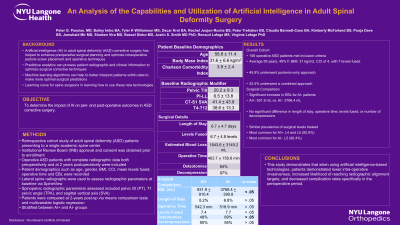An Analysis of the Capabilities and Utilization of Artificial Intelligence in Adult Spinal Deformity Surgery
Friday, April 21, 2023


Jamshaid M. Mir, MD
Research Fellow
NYU Langone Medical Center
Paterson, NJ, US
ePoster Presenter(s)
Introduction: AI has enhanced the orthopedic surgical tool kit by introducing a broad range of analytical advances that may offer enhanced preoperative planning, intraoperative robotic or navigational guidance, and prediction of post-operative complications. However, there remains a paucity of literature in regards to the utility of AI in ASD-corrective surgery.
Methods: Operative ASD patients with complete baseline (BL) and 2-year (2Y) radiographic/HRQL data were stratified by AI-based utilization and robotic or navigational assistance in pre- and peri-operative course (AI+) or not (AI-). Corrections were based on AI models linked to age, proportional alignment and frailty status algorithms to predict outcomes, junctional failure and thoracic compensations Means comparison tests and regression analysis assessed differences between pa
Results: 158 patients were included (57 AI+, 101 AI-). The cohort was 50% female, mean age of 58.8 yrs, BMI 31.6 kg/m2, CCI 3.9, and 6.6 levels fused. At baseline, patient groups were comparable in terms of BL radiographic parameters, all p < .05. Surgically, AI+ had significantly shorter operative times and EBL than AI-, both p < .05. AI+ had more combined approaches and less osteotomies overall, both p < .05. Post-operatively, AI+ patients were noted to have significantly improved segmental alignment in terms of decreased PT (p=.006), and improved global alignment per decreased TPA and SVA by 2Y, both p < .05. Compared to AI-, AI+ patients had a lower overall complication rate by 2Y (28.1% vs 47.5%), p < .05. in a multivariate analysis controlling for age, CCI, and invasiveness, AI+ patients were 61.6% less likely to experience a perioperative complication (OR .384 [CI .149-.989], p=.047).
Conclusion : This study demonstrates that when using artificial intelligence-based technologies, patients demonstrated lower intra-operative invasiveness, increased likelihood of reaching radiographic alignment targets, and decreased complication rates specifically in the perioperative period.
Methods: Operative ASD patients with complete baseline (BL) and 2-year (2Y) radiographic/HRQL data were stratified by AI-based utilization and robotic or navigational assistance in pre- and peri-operative course (AI+) or not (AI-). Corrections were based on AI models linked to age, proportional alignment and frailty status algorithms to predict outcomes, junctional failure and thoracic compensations Means comparison tests and regression analysis assessed differences between pa
Results: 158 patients were included (57 AI+, 101 AI-). The cohort was 50% female, mean age of 58.8 yrs, BMI 31.6 kg/m2, CCI 3.9, and 6.6 levels fused. At baseline, patient groups were comparable in terms of BL radiographic parameters, all p < .05. Surgically, AI+ had significantly shorter operative times and EBL than AI-, both p < .05. AI+ had more combined approaches and less osteotomies overall, both p < .05. Post-operatively, AI+ patients were noted to have significantly improved segmental alignment in terms of decreased PT (p=.006), and improved global alignment per decreased TPA and SVA by 2Y, both p < .05. Compared to AI-, AI+ patients had a lower overall complication rate by 2Y (28.1% vs 47.5%), p < .05. in a multivariate analysis controlling for age, CCI, and invasiveness, AI+ patients were 61.6% less likely to experience a perioperative complication (OR .384 [CI .149-.989], p=.047).
Conclusion : This study demonstrates that when using artificial intelligence-based technologies, patients demonstrated lower intra-operative invasiveness, increased likelihood of reaching radiographic alignment targets, and decreased complication rates specifically in the perioperative period.
